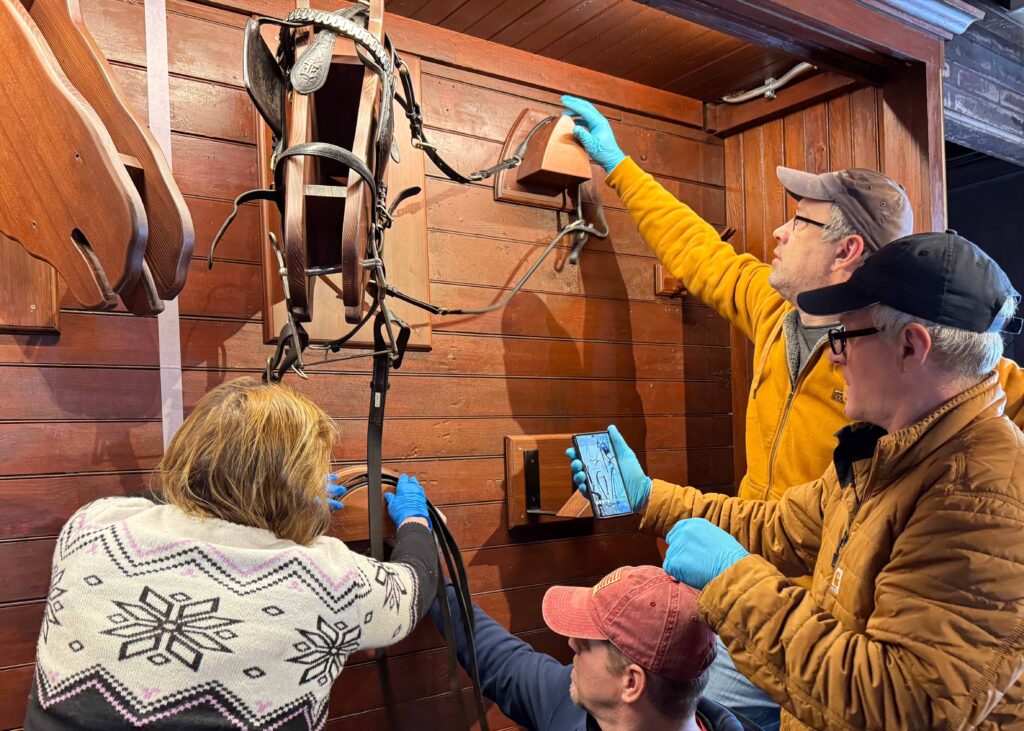If you were wandering around the halls and offices of Longyear Museum in recent months, you would have overheard several staff deeply immersed in talking about all things “tack.”
No, we don’t mean the little pin used to post items on a bulletin board. And we’re not referring to setting the course for a sailboat, either. Nor to the temporary stitches used in sewing.
Keep looking further down the list of dictionary definitions for tack … until you get to the part that refers to stable gear, or the various reins, straps, bits, buckles, and other items used in horseback riding or for harnessing a horse to a carriage.
That tack was the topic of discussions among our Collections, Historic House, Facilities, and Research and Communications teams, in preparation for creating a display in the 19th-century carriage house at Mary Baker Eddy’s final residence in Chestnut Hill, Massachusetts. This three-story stone building houses several horse-drawn carriages that belonged to Mrs. Eddy and were regularly used by her and her staff—as well as a large, floor-to-ceiling tack cabinet.1 The tack itself had been conserved by specialists some years ago but remained stored out of sight in the Museum vault awaiting its public debut.
As of a few weeks ago, the time had come to return the two sets of sturdy harnesses back to their original location—where they can be viewed up close by visitors. These items are not, however, placed as they would have been in a working carriage house circa 1910. Rather, they have been carefully positioned for a premium visitor experience so guests can envision the once-commonplace yet intricate process of preparing carriages and horses for an errand or a recreational drive.
It took teamwork!
Finalizing this neatly arranged display took a few months of planning, building, and review.
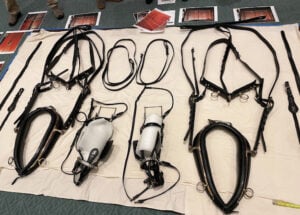
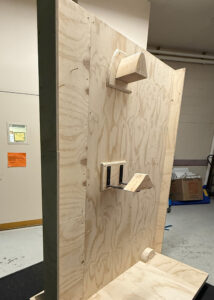
After carefully unwrapping and removing the harnesses from the Museum vault, each piece was placed on a large canvas sheet on the floor. Staff members consulted books, internet sources, colleagues with equestrian experience, and notes from past discussions with historic carriage experts to make sure all the pieces connected and fit together correctly. Then the team measured each item and agreed on overall placement in the tack cabinet.
The task of translating this floor-based layout into a vertical, wall-based display was taken up with enthusiasm by Longyear’s Facilities Specialist Paul Paradis, who has over 20 years of experience in woodworking and furniture making. Paul constructed a plywood “wall on wheels” to represent one half of the inside of the tack cabinet space. Using odds and ends of wood as placeholders, he plotted where specific items would hang as well as the spacing between them.
Applying specialized skills
The elaborate bridles, with their various straps, bits, and blinders, presented a challenge: Hanging them flat against a wall did not showcase their overall shape or utility, so Paul proposed using a 3-D form. After careful research into the breeds and standard dimensions of commonly-used carriage horses in 19th-century America, our Senior Graphic Designer Wendy Rankin put together a life-sized print of a horse’s head as a model.
Pasting this on a wall of his workshop (conveniently located in the basement level of the carriage house at 400 Beacon Street), Paul got to work. Using a jigsaw, he traced the gentle curves of horse’s nostrils and its sharp ears, then carefully carved out twin profiles which he joined with a block of wood between them to create dimension. It took three or four trial “fittings” of the bridles on the test forms—a bit more sawing here, some planing there—to settle on the right size.
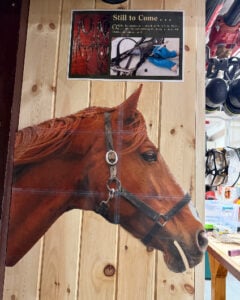
While the final horsehead shapes were built from store-bought lumber, all the other display mounts used recycled Douglas fir floorboards which had been removed from the original laundry room in the main house. Dulled by age and roughened by decades of use, these nearly 150-year-old planks went from a nondescript, grayish hue to their natural warm tones and distinctive grain after sanding. Clamping and gluing several Douglas fir boards together, Paul was able to create precisely shaped hangers for the horse collars and reins.
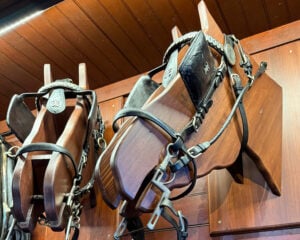
Putting it all together
Finally, the big day—or rather, days—arrived! On a rather chilly Monday afternoon, the historic tack was gently loaded into the Longyear van for transport to the Carriage House. The following morning, members of the three teams gathered for the installation. The original, glass sliding doors of the tack cabinet were removed, and work got under way. Keen eyes double-checked every position, angle, and placement, until the display met Longyear’s overall vision.
And now, here it is … a set of century-old artifacts ready to be enjoyed by visitors over the decades to come!
“I love that I could make a contribution in this unique way,” Paul says, as he surveys the exhibit. “It’s really awesome to be engaged in sharing and displaying something that was a daily part of Mary Baker Eddy’s life.”
We agree—this kind of work is pretty awesome, a privilege appreciated by all of us who work at Longyear Museum!
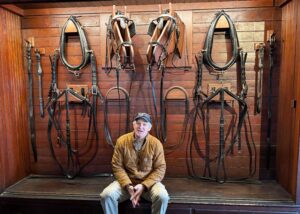
Photo at top of page: Many hands make light work! (From left to right, Collections Manager Sarah Sampson; 400. Beacon Street Site Manager Chris Rankin; Facilities Specialist Paul Paradis; Senior Manager of Historic Houses Rex Nelles)
P.S.: Keep an eye out for the next issue of the Longyear Review magazine, which delves into the purpose and perceptions of Mrs. Eddy’s tradition of daily carriage drives.
